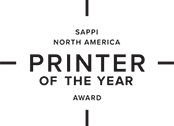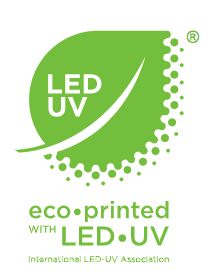
Everything you need to know about Eco Printed with LED UV
Frequently Asked Questions
- What is the difference between LED-UV and UV printing?
The fundamental difference between the UV and LED-UV is the light source. LED-UV generates an energy wavelength from light-emitting diodes (LED) at a light spectrum between 385 -395nm (nanometers.) Traditional UV produces an energy wavelengths between 260nm and 440nm from a mercury-vapor bulb. UV is far less efficient because only part of the wavelength generated is used o cure inks and adhesives. The unused portion is infrared energy that creates significant heat and ozone.
- What is the difference between LED-UV and conventional inks? Traditional inks are solvent-based and dry when chemicals evaporate over time. LED-UV inks are dried (cured) instantly using UV light.
- Is the process of LED-UV printing significantly different than printing with conventional inks? LED-UV and conventional printing are virtually the same, however, like with most new technologies, there tends to be a short learning period.
- Do I have to buy a new press to be a LED-UV printer? No, LED-UV and traditional UV curing units can be retrofitted to most existing presses.
- Do I have to switch ink rollers to print LED-UV? Yes, LED-UV links tend to cause traditional rollers to swell and shrink Plus, they will make it difficult to maintain the proper ink/water balance and generate additional heat from friction. There are two types of LED-UV rollers: EPDM for printing LED-UV exclusively, and Mixed-mode rollers for switching between LED-UV and conventional inks.
- Can I use my existing print blankets? No, LED-UV requires special blankets. Just like the rollers, EPDM blankets are used to print LED-UV exclusively, and a hybrid blanket is used for Mixed-mode printing.
- Can I use a conventional press and blanket wash with LED-UV? No, a specific UV compatible wash is required because LED-UV rollers and blankets have a different rubber composition compared to conventional print rollers and blankets.
- Do LED-UV inks really cost twice as much as conventional inks? LED-UV inks tend to be more expensive than conventional inks, however, he cost of ink typically represents only 1 % -2% of the total cost of any print job. P]us, there are several factors that offset the additional cost LED-UV inks increase the "mileage per pound"of ink especially when printing on offsets stocks because LED-UV inks are cured immediately on the surface of the substrate, minimizing absorption . Also, as more printers continue to adopt LED-UV technology, ink prices will continue to drop. (The price of ED-UV inks has dropped by nearly 20% during the past 2 years.)
- What other cost savings does LED-UV provide? Direct savings come from several areas including eliminating the need for spray powder and fewer MR sheets being used. Other LED cost saving areas include reduced energy consumption and eliminating the need to rack jobs. IR dryers generate significant heat which requires the HVAC system to run harder and longer in order to keep the pressroom comfortable. An LED-UV system doesn't generate any heat and requires up to 80% less power than an IR system. The absence of spray powder keeps the press area much cleaner, thus requiring less time spent cleaning and maintaining the delivery and allowing more time to run revenue-producing jobs. Because MR sheets are instantly cured, they can be used multiple times when using a closed-loop system reading the color bar. With LED-UV, jobs no longer need to be racked in the delivery. There is no need to allocate room for press loads to dry, which will improve the work-flow in the production area. Plus, aqueous coating is often given away at no-charge just to get the job into the finishing department sooner. With LED-UV, the days of giving away coatings for free are gone for good! Coatings are used only when they are part of the job design -and paid for by the customer! Turn times for each job are now determined by the length of the run, allowing increased flexibility downstream and an easier time scheduling jobs.
- What makes LED-UV "Green" and eco-friendly? LED-UV curing systems produce no VOC's (volatile organic compounds) to be released in Io the atmosphere creating greenhouse gases. Plus, unlike traditional UV systems, LED-UV contains no mercury and consume only 20% of the energy compared to a UV curing system or IR drier.
- Is the light emitted by LED-UV harmful to my operators? No, LED-UV systems produce ultraviolet output in the UV-A range, which is safer to humans than the shorter UV wavelengths generated by traditional UV mercury lamps. it is still recommended not to stare into the LED-UV light for extended periods of time.
- Is LED-UV chemistry caustic? As with all chemistry in a print shop. gloves and eye protection should be used. There is little difference between conventional and LED-UV washes. LED-UV inks and coatings contain in photo-initiators, which sometimes can cause a burning sensation or rash. These chemicals do not affect everyone in the same way, therefore, it is recommended that chemical handling procedures be followed regardless of the type of printing employed.
- Are other maintenance cleaning products required with LED-UV Printing? No, the same roller paste and calcium cleaning products can be used regardless of the type of printing. In fact, t these products are even more important when printing with LED-UV. The removal of all contaminates; like calcium and photo-initiators, will help keep the press running at peak performance. Plus, it's always good to have a comprehensive maintenance program for all mechanical equipment
- Can I use the same plates I am currently using? Yes, almost an CTP plates manufactured today are compatible with UV and LED-UV printing. The difference is the expected run length. Some plates will produce around 25,000 impressions, while others may produce as high as 250,000 impressions. If more than that is required, it is suggested that a plate vendor be consulted.
- Do I need to use a different fountain solution and alcohol substitute? No, it is not necessary to switch fountain solutions . During the start-up phase, it is recommended trying different formulas to maximum performance. A two-step fountain solution with a sub is recommended. It is ideal to apply the minimum amount of sub possible in order o have the maximum amount of adjustment. Some presses with a reverse nip dampening system tend to run better with a 1-step fountain solution. Of course testing various solutions is the best way to achieve the desired results.
- Can I use the current rubber metering roller? Yes, the metering roller is the same for all offset processes.
- Do I need to vent the delivery of my press? No, LED-UV does not require the press to be vented because LED-UV does not produce any heat or VOC's, thus there are no noxious smells generated.


